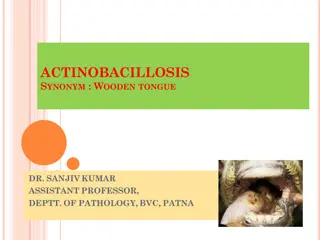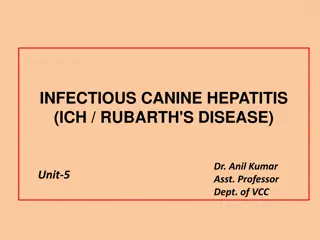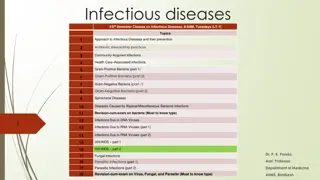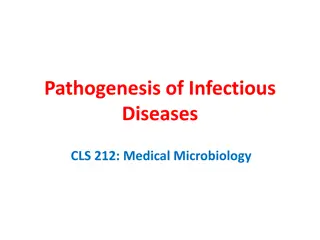Innovations in Infectious Disease Control: Insights from Experts
Explore the latest advancements in infectious disease control through the lens of renowned epidemiologists and researchers. Delve into the impact of the COVID-19 pandemic, the historical prevalence of infectious diseases, and early infection prevention practices. Uncover the evolution of infectious
0 views • 22 slides
Understanding Infectious Diseases: Transmission Methods
Learn about how infectious diseases are transmitted through various means such as food and water contamination, insect bites, direct and indirect contact. Enhance your knowledge of disease spread and prevention to stay healthy.
0 views • 17 slides
Livestock Monitoring Market Trend to be Worth $3.6 Billion by 2030
The early detection of a disease in a population of animals\u2014a herd of cattle, for example\u2014is particularly useful in controlling certain chronic infectious diseases, such as mastitis, brucellosis, and tuberculosis, as well as certain non-infectious diseases, such as bloat. With sensor techn
0 views • 8 slides
Update on Infectious Disease Prevention and H5N1 Vaccine Production
This content provides updates on infectious disease prevention efforts, including historical data, TB data posting schedule, and HIV surveillance updates. It also highlights the plans of the US Department of Health and Human Services to produce 4.8 million doses of the H5N1 avian flu vaccine for pan
0 views • 7 slides
Understanding Transmission of Infectious Diseases in Epidemiology
Exploring the various modes of transmission of infectious diseases, this content delves into how blood, internal fluids, genital fluids, droplets, coughing, airborne particles, and contact can spread pathogens like HIV, HBV, HCV, and more. It discusses the mechanisms and risks associated with each m
0 views • 21 slides
Understanding Emerging and Re-emerging Infectious Diseases
Emerging and re-emerging infectious diseases pose significant challenges to global public health, with factors such as increased human-animal contact and microbial resistance contributing to their spread. This presentation explores the definitions, examples, and impacts of these diseases, emphasizin
0 views • 22 slides
Mystery Case Study: 75-Year-Old Male with Fever and Altered Mental Status
A 75-year-old male with a history of multiple animal exposures presented with fever, altered mental status, headache, and diarrhea. Physical exam revealed vital signs within normal limits, and labs showed various results including negative infectious disease workup but pending further tests. Imaging
0 views • 11 slides
Understanding Disease Control and Prevention in Epidemiology
This article discusses disease control processes in epidemiology, including reducing disease incidence, duration, and transmission. It covers public policy interventions, elimination, eradication, and extinction of infectious agents. It also highlights preventable causes of disease and different lev
2 views • 10 slides
Understanding High Consequence Infectious Diseases (HCID)
High Consequence Infectious Diseases (HCID) encompass serious illnesses like Middle East Respiratory Syndrome (MERS), Ebola Virus Disease (EVD), and more. Patient screening for symptoms is crucial, and HCID is defined as diseases with high mortality rates and potential risks to healthcare personnel.
0 views • 70 slides
Anesthesia in Pediatric Epiglottitis: Update 2019
Infectious and non-infectious etiologies of epiglottitis, along with epidemiology, signs, symptoms, and differential diagnosis are explained in this comprehensive guide. Anesthetic techniques and antibiotic regimens for treating pediatric patients with epiglottitis are detailed, aiding in the identi
3 views • 22 slides
Actinobacillosis (Wooden Tongue) in Cattle and Sheep: Overview of the Infectious Disease
Actinobacillosis, also known as Wooden Tongue, is a specific infectious disease affecting cattle and sheep, caused by Actinobacillus lignieresii. It is characterized by fibrosis of the tongue and soft tissues, leading to mobility issues. The disease is primarily transmitted through wounds and abrasi
0 views • 8 slides
Understanding Fish Diseases and Health
Fish diseases and health are essential aspects of aquatic life. Diseases can be infectious or non-infectious, causing impairments to the normal state of fishes. Recognizing symptoms and signs of diseases is crucial for diagnosis and treatment. Overall, maintaining the health of fishes is vital for t
0 views • 21 slides
Comprehensive Overview of Infectious Diseases: Classes and Historical Perspectives
Infectious diseases are a significant public health concern, with various classes and prevention strategies discussed in a structured educational setting. The course covers topics ranging from antibiotic stewardship to viral infections, providing insights into the historical perspective of infectiou
0 views • 32 slides
Canine Infectious Hepatitis (ICH) - Overview, Symptoms, and Treatment
Canine Infectious Hepatitis (ICH), also known as Rubarth's Disease, is caused by Canine Adenovirus-1 (CAdV-1), affecting dogs of all ages. The virus primarily targets hepatocytes, leading to acute hepatitis, as well as respiratory and ocular issues. Transmission occurs through contact with infected
6 views • 7 slides
Infectious Diseases 4/5th Semester Classes: Approach & Prevention
Infectious Diseases class focuses on various topics including Antibiotic Stewardship Practices, Community-Acquired Infections, Gram-Positive and Gram-Negative Bacteria, Spirochetal Diseases, Diseases Caused by Bacterial and Viral Infections, HIV/AIDS, Fungal and Parasitic Infections. The class also
3 views • 30 slides
Understanding the Normal Flora of the Gastrointestinal Tract and Infectious Diarrhea
Explore the common normal flora of the gastrointestinal tract (GIT) and how they play a role in health and disease, specifically focusing on infectious diarrhea. Learn about different types of acute diarrheal illnesses, epidemiology, host defenses against GI infections, and the pathogenesis of bacte
0 views • 38 slides
Understanding Pathogenicity in Infectious Diseases and Parasitism
Pathogenicity refers to the ability of a pathogen to cause disease in plants, humans, and animals. Infectious diseases and parasitism play key roles in the spread and development of epidemics. Parasites can hinder the normal growth of plants by extracting nutrients, while different types of parasite
0 views • 5 slides
Approach to Infectious Diseases: Antibiotic Stewardship, Bacterial Infections, and HIV/AIDS Clinical Staging
In the 4th-5th semester classes on infectious diseases, topics such as antibiotic stewardship, community-acquired infections, and various bacterial diseases are covered. The clinical manifestations and WHO clinical staging of HIV/AIDS for adults and adolescents are also discussed in detail. The cour
0 views • 29 slides
Understanding Infectious Ectromelia in Laboratory Animals
Infectious Ectromelia, also known as Mousepox, is a viral disease causing high mortality in adult mice and limb amputation in surviving cases. It is characterized by skin lesions, rash, and generalized fatal disease. Various strains of the virus exist, with transmission occurring through abrasions o
0 views • 16 slides
Comprehensive Guide to Certification in Infectious Disease Management
Dive into the world of infectious disease management certification with this comprehensive guide covering exam topics such as identifying infectious disease processes, surveillance, prevention/control strategies, employee health, and management/communication skills. Prepare yourself to excel in your
0 views • 19 slides
Essential Guidelines for Safe Laundry Handling in Infection Prevention & Control
Laundry management is crucial in preventing infection spread. Key practices include washing hands between handling clean and used laundry, preventing cross-contamination, storing laundry properly, and handling used laundry safely. Categorize laundry into clean, used, and infectious types, and follow
0 views • 11 slides
Kennel Cough: Contagious Canine Respiratory Disease Overview
Kennel Cough, known as Canine Infectious Tracheobronchitis, is a highly contagious respiratory disease affecting dogs, characterized by acute tracheobronchitis and a paroxysmal cough lasting several days. It is caused by various infectious agents, including Canine Parainfluenza Virus and Bordetella
0 views • 12 slides
Comprehensive Overview of Infectious Diseases and Symbiosis in Academic Setting
This academic course covers a wide array of topics related to infectious diseases, including antibiotic stewardship, bacterial infections, viral diseases like HIV/AIDS, fungal and parasitic infections, and parasite life cycles. Additionally, it delves into the intricacies of symbiosis, exploring com
0 views • 24 slides
Overview of Pathogenesis in Infectious Diseases
This content provides valuable information on the pathogenesis of infectious diseases, including definitions, phases of disease progression, types of infections, acute vs. chronic diseases, signs vs. symptoms, steps in pathogenesis, and ways pathogens can enter the body. It discusses the importance
0 views • 15 slides
Understanding the Pathogenesis of Infectious Diseases
The pathogenesis of infectious diseases involves the development of a disease caused by a pathogen, with phases like incubation, prodromal, illness, and convalescent periods. Infections can be localized or systemic, acute, subacute, or chronic. Differentiating signs and symptoms, recognizing latent
0 views • 17 slides
Emerging Infectious Diseases Data Analysis Exercise for Australia-Indonesia Partnership
Explore the data analysis exercise conducted under the Australia-Indonesia Partnership for Emerging Infectious Diseases. The exercise involves tasks such as analyzing total animals of each species, vitamin usage, disease prevalence, seasonal patterns, and data cleaning techniques. Various images ill
0 views • 7 slides
Fever Associations and Clinical Presentations in Tropical Medicine and Gastroenterology
This presentation by Dr. Amr Ahmed Hamed, a lecturer at Sohag University, explores various fever associations and clinical presentations related to tropical medicine and gastroenterology. Topics covered include fever with jaundice, sweating, rigors, hepatomegaly, splenomegaly, rash, lymphadenopathy,
0 views • 25 slides
Comprehensive Overview of Infectious Foot Rot (IFR) in Ruminants
Infectious Foot Rot (IFR) is a contagious disease affecting ruminants worldwide, characterized by severe interdigital dermatitis and lameness. It is caused by Fusobacterium necrophorum and other bacteria, leading to inflammation of the sensitive foot tissues. Various predisposing factors and modes o
0 views • 13 slides
Lithuanian Society for Infectious Diseases: Advancing Infectious Diseases Diagnostics, Treatment, and Prevention
Lithuanian Society for Infectious Diseases is a non-profit organization in Lithuania that brings together healthcare professionals to improve the diagnosis, treatment, and prevention of infectious diseases. They participate in various initiatives, events, and collaborations, organize conferences, an
0 views • 7 slides
Canine CSF Proteomic Profiling for Non-Infectious Meningoencephalitis Biomarker Discovery
This study focuses on using mass spectrometry to analyze cerebrospinal fluid (CSF) proteomics in dogs with non-infectious meningoencephalitis, aiming to identify unique peptide signatures for improved diagnosis and monitoring. The research addresses the diagnostic and therapeutic limitations of this
0 views • 16 slides
Understanding Infectious Diseases: Approach, Prevention, and Viral Agents
Infectious diseases play a significant role in public health, with a focus on antibiotic stewardship, community-acquired and healthcare-associated infections, as well as various bacterial, viral, fungal, and parasitic agents. Specific topics include the prevention of infectious diseases, with a deta
0 views • 18 slides
Understanding Pathogens and Immune Response Mechanisms
Pathogens, such as bacteria, viruses, and fungi, can cause infectious diseases in humans, animals, and plants. The immune system defends against these pathogens through various mechanisms, including the production of antibodies, phagocytosis, and the activation of specific defense cells like white b
0 views • 4 slides
Understanding the Spread of Infectious Diseases
Explore the dynamics of disease spread, vaccination effects, and simulation activities in a lesson on infectious diseases. Dive into data analysis and Koch's postulates to understand the role of infectious agents in disease causation.
0 views • 10 slides
Importance of Universal Precautions in Schools
Universal Precautions are practices that help protect employees and students in schools from exposure to potentially infectious materials like blood. By using protective barriers, washing hands thoroughly, and cleaning contaminated surfaces, the risk of spreading infections is reduced. It's crucial
0 views • 12 slides
Infectious Disease Control in the Russian Federation
Infection control in the Russian Federation is managed by various agencies and organizations, with a focus on surveillance, prevention, and outbreak response. The country registered millions of cases of infectious diseases, with upper respiratory tract infections being prevalent. The anti-plague ser
0 views • 16 slides
Understanding Lower Genital Tract Infections: Causes, Symptoms, and Treatment
Lower genital tract infections encompass conditions like vulvitis, vaginitis, and cervicitis, with causes ranging from irritants to infections. Symptoms include itching, discharge, and swelling. Treatment involves identifying and addressing the underlying cause, whether infectious or non-infectious,
0 views • 43 slides
Understanding Infectious Diseases and Prevention Strategies
Infectious diseases are caused by pathogens like bacteria, viruses, parasites, or fungi invading the body. These diseases can spread from person to person and sometimes from animals to humans. Common characteristics include potential severe outcomes, transmission modes, and the role of pathogens. Th
0 views • 27 slides
Respiratory Diseases in Cattle: Causes, Infections, and Management
Respiratory diseases in cattle primarily stem from infectious agents such as infectious bovine rhinotracheitis and Pasteurella spp. These diseases compromise the defense mechanisms of the body, leading to infections like pneumonia and pleuropneumonia. Viruses, mycoplasmas, and bacteria like Histophi
0 views • 31 slides
Investigation & Outbreak Tools in Infectious Disease Control
Explore a comprehensive guide to investigation and outbreak tools in infectious disease control, including types of tools, recommended books, useful websites, subject matter experts, and resources from the Texas Department of State Health Services. Discover essential resources for field epidemiologi
0 views • 18 slides
Strategies to Reduce Hospitalization and Improve Infectious Disease Management
Explore the importance of limiting hospitalization for infectious diseases, reducing risks, and adding value to patient care through the experiences shared by Dr. Ronald G. Nahass. The case study highlights the impact of inappropriate diagnosis and delayed consultations with infectious disease speci
0 views • 31 slides







































